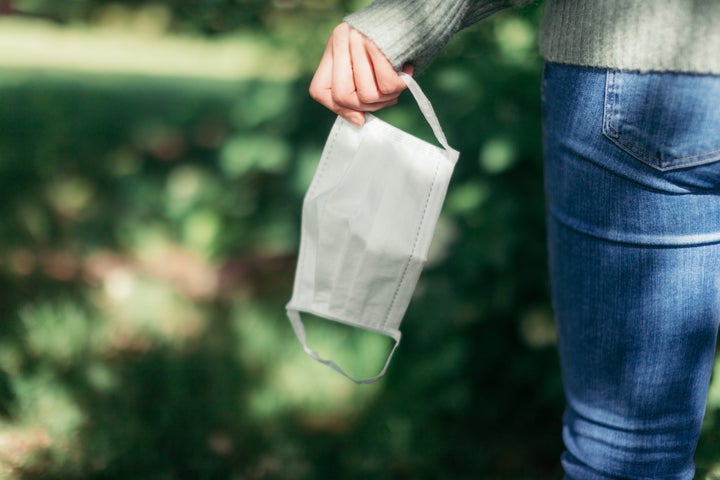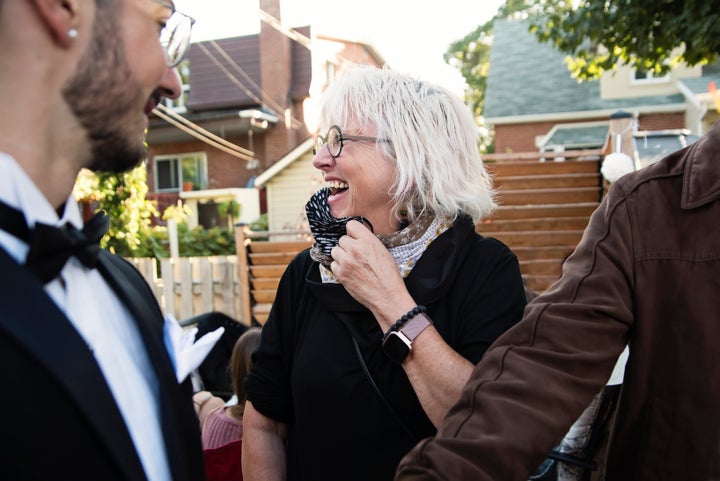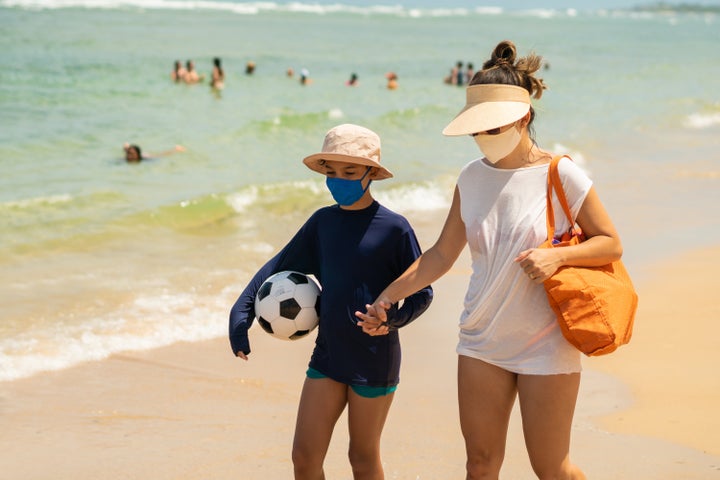
Outdoor activities are much safer than socializing indoors, and both vaccinated and unvaccinated people can ditch their masks in certain distanced scenarios, according to the most recent guidance from the Centers for Disease Control and Prevention. But the advice gets more murky when you factor in the number of people involved and whether they’re vaccinated.
In general, infectious disease experts say unvaccinated people should wear masks in crowded outdoor settings but can feel free to go maskless if they’re able to put a few feet between themselves and other unvaccinated people. Vaccinated people, meanwhile, are well protected both indoors and outdoors.
The main gist here is that outdoor transmission rarely happens and masks aren’t necessary outside unless there are packed crowds. There’s a ton of evidence out there showing that outdoor transmission is very rare. A recent study from Ireland found that just 0.1% of cases were linked to outdoor transmission.
But there’s a little bit of nuance to all this: It depends on what the activity is, how many people are involved and what your individual risk tolerance is like.
Unvaccinated people are still at risk of getting COVID. Because the wind, air and sunshine effectively disperse viral particles, chances are slim you’d be exposed to enough viral particles to make you sick if you’re unvaccinated and pass by someone with COVID outside. If there are a lot of people nearby, though, your risk (and need for a mask) goes up.
Vaccinated people have an incredibly low risk of getting COVID, period, but that risk is essentially negligible in outdoor settings. Strictly going off the science, there’s no strong medical reason vaccinated people need to wear masks outside, infectious disease experts say. (It’s polite to wear once in public spaces where mask-wearing is the social norm, however.) There is some preliminary evidence that suggests certain people who are severely immunocompromised may not produce a strong immune response after vaccination. For these people, a mask can provide an extra layer of protection — talk to your doctor and weigh your personal risk.
Generally speaking, however, here’s a brief face mask guide to follow when it comes to outdoor activities:
Dining outside
If you’re unvaccinated: Ideally, you’d be eating out with your household or with people who are vaccinated. Sitting and eating at a table with unvaccinated people from other households does come with a risk.
“Most of the documented transmission events that have occurred outdoors involve face-to-face conversation,” said Linsey Marr, a professor of civil and environmental engineering at Virginia Tech who studies airborne viruses. She recommends finding a restaurant where the tables are 10 feet away from one another. “Regardless of whether you follow these guidelines, dining outdoors is safer than dining indoors under almost all circumstances.”
If you’re partially vaccinated (aka in between doses): You do have some protection a couple of weeks after your first dose, but you really need that second dose for full protection. Ventilation is amazing outside, which makes dining out a pretty safe ― though not risk-free ― activity for you. If you want to take off your mask, try to sit about 3 feet from other tables or unvaccinated people, per guidance from the World Health Organization.
If you’re fully vaccinated (aka two weeks out from your last or only dose): You don’t need to wear a mask, but be considerate of others who may be unvaccinated. Eating outdoors is very low-risk for vaccinated people.
“When interacting with the server, it would be courteous to wear your mask because the waiter doesn’t know if you’re vaccinated or not,” Marr said.

An outdoor gathering or wedding
Unvaccinated: It depends on how crowded the event is. If you can social distance, “a mask will likely provide very little benefit,” said Amesh Adalja, a senior scholar at the Johns Hopkins University Center for Health Security and an infectious disease expert. If you’re not able to social distance and are mingling with other unvaccinated people, a mask can help keep you safe and protect others if you happen to be infected.
Partially vaccinated: If you can social distance, you don’t have to wear a mask. The more space, the better, but the WHO says at least 3 feet is sufficient. If you can’t physically distance and this is a packed event, wearing a mask is the safest bet.
Fully vaccinated: You are well protected and a mask isn’t necessary. “In general, I tell vaccinated people they should go back to their normal pre-pandemic life as much as they want,” Adalja said.
An outdoor stadium or concert
Unvaccinated: It really depends on how many people are sitting nearby. If capacity is limited and you’re surrounded by empty seats, the risk is low and you can take off your mask, Marr said. She would, however, recommend masking up in the bathroom. And if the stadium or venue is at full capacity and you’re sitting next to other people, you’ll want to wear a mask.
Partially vaccinated: A partially vaccinated person who has received only the first dose would be safest wearing a mask, Adalja said. In general, though, a mask isn’t going to provide much more benefit if social distancing is possible.
Fully vaccinated: You’ve got protection from the vaccines and the open air, so the chances of getting sick are minimal. You’ll be pretty safe without a mask, but most venues and stadiums require them, so you should plan to wear one. Severely immunocompromised individuals should talk to their doctor and evaluate their personal risk.
A playground
Unvaccinated: Unless you’re sitting among a group of people, you don’t need to wear a mask. This goes for kids, too, who are less likely than adults to transmit the virus and are less likely to get sick even if they are exposed, said Monica Gandhi, an infectious disease specialist at the University of California, San Francisco. “No need to mask up given the low risk of outside transmission,” Gandhi said.
Partially vaccinated: The same advice applies.
Fully vaccinated: This is safe and you don’t need a mask — but if you’re within a couple of feet of other people and they’re masking up, it’d be the polite thing to do. Again, no one can tell who has or hasn’t been vaccinated.
Hiking, jogging or biking
Unvaccinated: Unless you’re in a large group of unvaccinated people, you don’t need a mask. “Passing by just one or two people typically does not provide an opportunity to be exposed to enough virus to cause infection,” Marr said. She recommended not following someone too closely for too long — you don’t want to be in their stream of droplets.
Partially vaccinated: Same as above, with your risk being even lower than when you’re completely unvaccinated (which is already low to begin with).
Fully vaccinated: No need for a mask. This is very safe!

A beach or park
Unvaccinated: Hanging out at the beach or going to a park are some of the safest things to do during the pandemic. Because you’re out in the fresh, open air, a mask isn’t necessary. Gandhi said she’d “only have unvaccinated people wear a mask if at a densely packed rally in a park.”
Partially vaccinated: Same as above.
Fully vaccinated: Going to the park or beach is incredibly safe. Feel free to take off your mask, Gandhi said.
A protest or rally
Unvaccinated: A mask is a good idea. “A protest adds the risk of shouting, chanting and screaming, which would increase transmission efficiency,” Adalja said. Pepper spray and tear gas can also cause people to cough and spit, and therefore expel respiratory droplets.
Partially vaccinated: The safest thing to do if you’re protesting but have only received one dose: Wear a mask. If the protest or rally is spaced out, you’ll be OK without one.
Vaccinated: You don’t need to wear a mask — but other people protesting don’t know if you’re vaccinated, so it’s the polite thing to do.
Outdoor sports
Unvaccinated: When playing outdoor sports where you are mostly a few feet from other players — like tennis, golf, baseball or kickball — it’s OK to not wear a mask, according to Gandhi. Mask up for outdoor sports where you’re up close and huffing and puffing on one another, like soccer or basketball.
Partially vaccinated: Gandhi said it’s totally fine for partially vaccinated individuals to play certain sports outside without masks, due to how low the rate of outdoor transmission is. If it’s a close-contact sport, masking up is still the safest route.
Fully vaccinated: You’re good. The vaccines work well, so Gandhi said you can play maskless. Go with the league’s policies, though.
A community pool
Unvaccinated: Mask if you can’t social distance. The coronavirus can’t survive in chlorinated water, so the infection isn’t going to spread in the pool water itself, Adalja said. If the pool is packed and you can’t physically distance from other swimmers, bring a mask (just don’t wear it under water). But if you can create some space between you and other swimmers, you’ll be fine wading without a mask.
Partially vaccinated: Again, the safest bet is to wear a mask if it’s packed. If you can appropriately distance from others, don’t worry about a mask.
Fully vaccinated: No need to wear a mask — unless the pool has policies requiring swimmers to do so.
Walking around a busy street, market or downtown area
If you’re unvaccinated: “Transient contact is not a major transmission risk, so it’s something I would leave to a person’s individual risk tolerance,” Adalja said. If people are packed like sardines on the sidewalk, a mask will be helpful — but most people will be fine without one, assuming they can dodge other people.
Partially vaccinated: Same deal. You’re likely OK for the most part, but bring one with you just in case you get close to others.
Fully vaccinated: Breathe in that fresh city air! Follow the local guidance but know you’re well protected, mask or no mask.
As more people get vaccinated and as community transmission drops, the need for masks will decrease. Keep an eye on cases in your area and know that the great outdoors is one of your biggest weapons in protecting yourself against the coronavirus.
Experts are still learning about COVID-19. The information in this story is what was known or available as of publication, but guidance can change as scientists discover more about the virus. Please check the Centers for Disease Control and Prevention for the most updated recommendations.